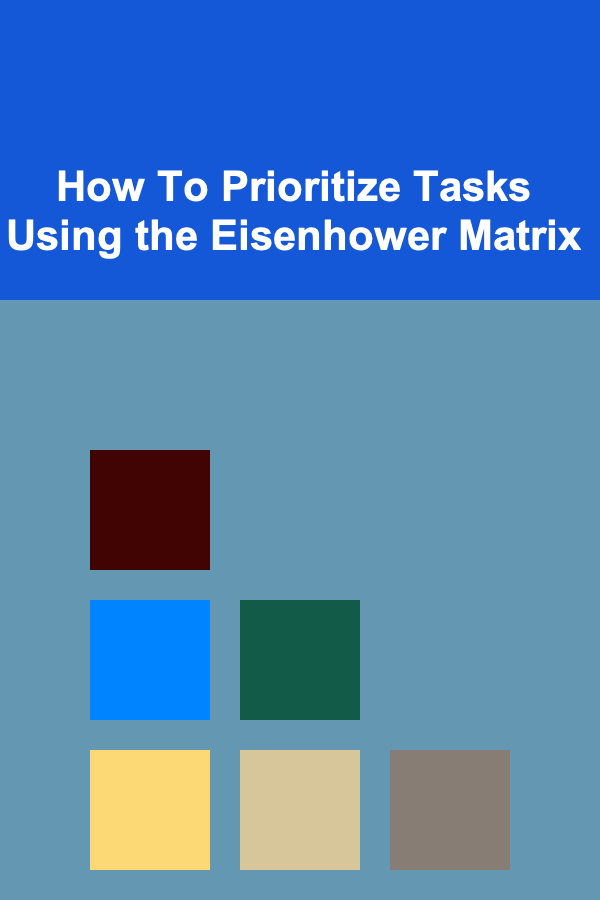
How To Prioritize Tasks Using the Eisenhower Matrix
ebook include PDF & Audio bundle (Micro Guide)
$12.99$6.99
Limited Time Offer! Order within the next:

The Eisenhower Matrix is a time management tool that helps individuals and organizations decide on the urgency and importance of tasks to improve productivity and decision-making. Named after Dwight D. Eisenhower, the 34th President of the United States, who was known for his extraordinary ability to manage tasks, this matrix is an essential tool for effective time management and prioritization.
In this article, we will explore the Eisenhower Matrix in-depth, its history, how it works, and how to apply it to your daily life to increase efficiency and reduce stress.
Introduction to the Eisenhower Matrix
The Eisenhower Matrix, also known as the Urgent-Important Matrix, helps people categorize tasks based on their urgency and importance. It divides tasks into four distinct categories:
- Urgent and Important (Do First)
- Important, but Not Urgent (Schedule)
- Urgent, but Not Important (Delegate)
- Neither Urgent nor Important (Eliminate)
By distinguishing tasks this way, the matrix allows you to focus on what truly matters and avoid getting distracted by things that do not contribute to your long-term goals.
The matrix emphasizes that not everything that seems urgent is important, and not everything that is important is urgent. Recognizing this distinction is vital for effective time management, decision-making, and stress reduction.
The History of the Eisenhower Matrix
The Eisenhower Matrix is often attributed to President Dwight D. Eisenhower, who famously said:
"What is important is seldom urgent and what is urgent is seldom important."
Eisenhower was known for his ability to manage a highly demanding life as a general during World War II and later as a president. He had to make countless decisions daily, many of which required him to prioritize tasks based on their urgency and importance.
The matrix that bears his name was not formally created by Eisenhower, but rather by his recognition of how essential it was to focus on what was truly important, not just what was pressing. He understood that doing important tasks well in advance could prevent future stress and create long-term success.
Understanding the Four Quadrants of the Eisenhower Matrix
1. Urgent and Important: Do First
Tasks in this quadrant are both urgent and important. They are the ones that demand immediate attention and cannot be delayed. These are typically crises, emergencies, or tasks with tight deadlines.
Examples:
- Handling a medical emergency
- A client-facing issue that requires immediate resolution
- An impending work deadline with significant consequences
When faced with a task in this category, you should prioritize it above all others. Ignoring these tasks could lead to severe consequences, so addressing them swiftly is essential.
How to Approach This Quadrant:
- Act Immediately: Since these tasks are both urgent and important, they require your full attention right away. Avoid distractions and focus on solving the issue at hand.
- Time-Box: Once the issue is addressed, try to set limits on the amount of time you spend on it to prevent spending more time than necessary.
- Delegate If Possible: If you can delegate parts of the task to others while still ensuring quality and timeliness, do so.
2. Important, but Not Urgent: Schedule
This category is for tasks that are important but do not have immediate deadlines. These tasks may not demand your attention right away, but they are critical to achieving long-term goals and success.
Examples:
- Planning for a future business project
- Developing a new skill or competency
- Building personal relationships and networking
These tasks are often the ones that get pushed aside because they are not urgent, but they can make the biggest difference in the long run. Neglecting them can lead to stress later, as tasks in this quadrant may eventually become urgent.
How to Approach This Quadrant:
- Schedule Time: Block off time in your calendar for these tasks. Since they are important but not urgent, it's easy to procrastinate. Having a dedicated time to focus on them ensures progress.
- Plan for the Future: These tasks often require long-term effort. Break them down into smaller, manageable steps to keep them from becoming overwhelming.
- Review Regularly: Make sure to revisit these tasks periodically to assess progress and realign your efforts as necessary.
3. Urgent, but Not Important: Delegate
Tasks in this category are urgent, but they are not crucial to your long-term goals. These are often interruptions or requests that require immediate attention but do not significantly impact your personal or professional development.
Examples:
- Answering a phone call that could have been an email
- Attending a meeting that doesn't contribute to your work
- Responding to non-urgent emails or messages
These tasks may feel like they need to be addressed right away because they are urgent, but they are not important in the grand scheme of things. They often take time away from more important activities.
How to Approach This Quadrant:
- Delegate to Others: If possible, delegate these tasks to others who can handle them. If they require a response, see if you can redirect them to someone more suited to the task.
- Automate: Where applicable, set up processes or systems to handle these tasks automatically. This can include using email filters or scheduling tools to streamline these types of tasks.
- Limit Distractions: Set boundaries to avoid these interruptions in the future. Minimize the time spent on tasks in this quadrant by deflecting them or automating them.
4. Neither Urgent Nor Important: Eliminate
Tasks in this category are neither urgent nor important. They provide little to no value and are often distractions that waste time.
Examples:
- Watching irrelevant TV shows or browsing social media aimlessly
- Engaging in gossip or unproductive activities
- Doing tasks that do not align with your goals
While these tasks may feel comfortable or serve as a temporary escape, they are ultimately distractions. These tasks take up valuable time that could be better spent on more meaningful activities.
How to Approach This Quadrant:
- Eliminate or Avoid: If something doesn't add value or align with your long-term goals, remove it from your schedule. You'll find that your time becomes more focused and productive.
- Be Mindful of Time: Set time limits on activities that fall into this quadrant. For example, allow yourself a set amount of time to relax and then get back to more important tasks.
- Focus on What Matters: By eliminating time-wasting activities, you free up space for tasks in the other quadrants that align with your values and objectives.
Benefits of Using the Eisenhower Matrix
- Improved Time Management: The matrix helps you identify where to focus your time and energy. By categorizing tasks, you can allocate your resources more effectively.
- Reduced Stress: Knowing which tasks to prioritize reduces the feeling of being overwhelmed by a never-ending to-do list. You'll spend less time reacting to crises and more time focusing on what's important.
- Increased Productivity: By regularly reviewing and prioritizing tasks, you ensure that you're always working on the most impactful tasks, driving you toward your goals more efficiently.
- Better Decision Making: The matrix forces you to think critically about the true urgency and importance of tasks, leading to more informed and deliberate decision-making.
Applying the Eisenhower Matrix to Your Life
To start using the Eisenhower Matrix, follow these steps:
- List Your Tasks: Write down everything you need to do, no matter how big or small. This will include work-related tasks, personal tasks, and anything else on your mind.
- Categorize Your Tasks: Using the four quadrants of the Eisenhower Matrix, categorize each task as urgent and important, important but not urgent, urgent but not important, or neither urgent nor important.
- Take Action: Focus on completing tasks in the first quadrant immediately. For tasks in the second quadrant, schedule time to work on them. Delegate tasks in the third quadrant, and eliminate or minimize tasks in the fourth quadrant.
- Review Regularly: At the end of each week, review your tasks and adjust your priorities. The Eisenhower Matrix is an ongoing process that requires regular updates to remain effective.
Conclusion
The Eisenhower Matrix is a powerful tool for anyone looking to improve their time management skills and prioritize tasks effectively. By categorizing tasks based on their urgency and importance, you can focus on what truly matters, eliminate distractions, and reduce stress. Whether you're a busy professional, a student, or someone looking to optimize personal productivity, the Eisenhower Matrix can help you navigate the complexities of daily life and move toward your long-term goals with greater ease and efficiency.
By making the matrix a part of your daily routine, you can create a framework that empowers you to make better decisions, work smarter, and achieve the results that matter most.
Reading More From Our Other Websites
- [Paragliding Tip 101] Choosing the Right Wing Shape for Your Flying Style and Conditions
- [Biking 101] The Ultimate Guide to Bike Locks: Which One is Most Secure?
- [Personal Investment 101] Building AI-Powered Products to Generate Passive Income
- [Reading Habit Tip 101] Genre-Specific Gems: The Ultimate Reading List for Mystery Lovers
- [Simple Life Tip 101] How to Simplify Your Wardrobe Using the 12‑Item Capsule Method
- [Weaving Tip 101] Threads of Renewal: How Weaving Symbolizes a Fresh Start
- [Personal Finance Management 101] How to Set Financial Goals and Achieve Them
- [Home Renovating 101] How to Renovate Your Home's Insulation for Better Energy Efficiency
- [Paragliding Tip 101] Wind Whisperers: How to Read and Leverage Wind Patterns for Safer Launches
- [Personal Finance Management 101] How to Save Money by Cutting Out Expensive Habits

How to Create a Space for Writing and Note-Taking
Read More
How to Create Opportunities for Dramatic Play
Read More
How to Utilize Area Rugs for Defining Spaces
Read More
How To Learn to Write Your Own Songs
Read More
How to Invest in Mutual Funds
Read More
10 Tips for Meal Planning with Baked Goods
Read MoreOther Products

How to Create a Space for Writing and Note-Taking
Read More
How to Create Opportunities for Dramatic Play
Read More
How to Utilize Area Rugs for Defining Spaces
Read More
How To Learn to Write Your Own Songs
Read More
How to Invest in Mutual Funds
Read More